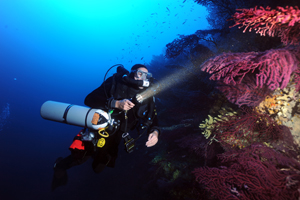History of Scuba Rebreathers with TDI
Promoting Bubble-Free Diving for Close to 20 Years

As a matter of fact, we were wondering how long it would be before the rest of the scuba diving industry caught on and realized that for a growing number of divers, rebreathers really are the very best option to help them get the most bang for their bottom-time buck.
Another small reminder for those looking seriously at giving rebreathers a try sometime this season is that although the Tech Diving Agencies often get accused of keeping all the really fun stuff for themselves — and rebreathers certainly fall into the fun category — TDI has been actively offering rebreather training to active sport divers since the agency opened its doors in 1994. Along the way, through changes and innovations in rebreather design and technology, TDI has kept working hard at being “rebreather friendly” and demystifying what is surely the most rapidly expanding market segment in diving.
TDI’s association with rebreathers started when Bret Gilliam (TDI’s founder and guiding light for the first decade of the agency’s existence), and a handful of the first cadre of diving instructors and regional managers, put together a comprehensive teaching/learning package for the Drager Dolphin. The Drager Dolphin was a semi-closed rebreather based unit designed for military service but rigged to appeal to recreational divers who were interested not in great depth or long cave penetrations but simply logging more bottom-time and getting closer to marine life with their cameras.
Almost every piece of promotional material and many of the “Hall of Fame” framed photos hanging on the walls of TDI’s Florida offices feature pictures of Drager units being used in places as far apart as Fiji, Florida and the Fjords of Norway. Many of TDI’s more experienced rebreather instructors — the men and women who’ve racked up literally thousands of underwater hours and diver wearing the agency colors — cut their teeth on those early SCR units.
In the mid to late 90s, general interest in closed-circuit rebreathers started to peak; these more complex, more flexible, and more “techie” units began to appear at dive sights all over the world, but particularly in Europe, which seemed to be more ready to drop the bubble-making habit than North America.
Perhaps one thing affecting popularity was that up until this point, finding an instructor and getting quality training on a CCR was about as difficult and mysterious to most divers as becoming a spy. The turn-around, and what many considered the tipping point which “would make rebreathers mainstream,” was TDI publishing student and instructor materials for CCR units from two best-selling manufacturers: Kiss Rebreathers (makers of the Classic and Sport CCR) and Ambient Pressure Diving (makers of the Inspiration and Evolution computer-controlled units). These easy to understand and manufacturer-sanctioned reading materials, coupled with industry-leading standards for rebreather instructors, meant that many recreational and sport divers started to look at CCRs as a viable alternative to traditional open-circuit scuba for many kinds of diving, from open-water reefs and fish photography to cavern, cave and wreck exploration.
By the mid to late 2000s, TDI sanctioned a full list of rebreather certification programs for very different machines from more than a dozen manufacturers situated around the globe: SCRs, and various types of diver-controlled, computer-controlled, and fully automatic CCRs.
During that period TDI produced standards for Poseidon’s “Recreational” CCR, the Discovery. This unit has many features that the agency felt made it particularly suitable for sport divers.
“The design and engineering of Poseidon’s entry-level unit offered many of the features and automated checks that we felt necessary to really make CCR technology available and appealing to divers who did not want the bother and complexity they associated with a “full-blown” closed-circuit rebreather,” explains Brian Carney, president of International Training (the governing company of SDI, TDI and ERDI). “It was quite simply a game-changer.”
With some prior knowledge of the way the market was leaning, and based on feedback from the dive community and rebreather manufacturers, TDI’s training department made an unprecedented change to its standards in the late 2000s.
Essentially, the chance was adding a “recreational-level” program to its rebreather curriculum. This additional program was applied to ALL units from each of the manufacturers supported by TDI. This program was intended for divers with little open-water experience and covered them for dives to 30 meters or less, with no decompression. Most popular of all, the program materials covered the topics traditionally covered in TDI’s Advanced Nitrox Program and did away with the requirement that this level of training was a prerequisite for the CCR course. This was a popular move with instructors and divers.
As the rebreather market expands and more and more divers decide that there is a rebreather in their future, it’s worth noting that TDI and its core of professional rebreather instructors have been promoting, teaching and refining no-bubble dives since 1994.
Got your interest? Learn more about Rebreathers and plan to embark on your “Silent Adventure!” Visit https://www.tdisdi.com TODAY to learn more.
Contact TDI SDI and ERDI
If you would like more information about redundant air sources or to schedule an appointment with TDI, please contact:
TDI
Tel: 888.778.9073 | 207.729.4201
Email: Worldhq@tdisdi.com
Web: https://www.tdisdi.com
Facebook: www.facebook.com/TechnicalDivingInt


Hinterlasse einen Kommentar
An der Diskussion beteiligen?Hinterlasse uns deinen Kommentar!